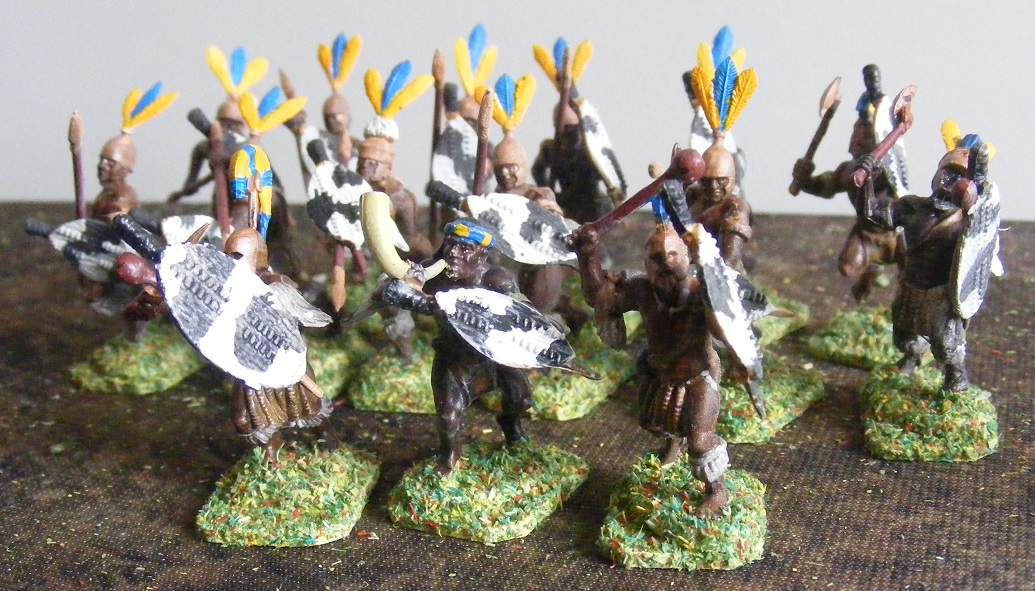AKSHEBA
This land is
ruled by hereditary queens all of whom, on taking the throne, adopt the
title/name Qandaqe (or Candace or Kandake).
It is a hilly and forested land flanked by wide, deep rivers.
The land produces vast quantities of high quality iron, gold, silver,
excellent wine and beef. The rivers
are the main routes and boats the main means of transport and virtually all
settlements (other than mines) lie along them.
Due to prevalence of what Korinithian doctors call
hippomoiraios (horse death), a disease carried by stinging flies that infects
non-native horses, drives them uncontrollably mad and then kills them in a
matter of a few days. Conventional
cavalry, therefore, is seldom seen on the battlefield though their place is
taken by zebra centaurs who are immune.
Recruited from the youths of the aristocracy a light cavalry force can
occasionally be found mounted on some of the very few local horses.
They generally perform scouting, foraging, skirmishing and occasionally
combat missions. The bulk of the
armies are fast moving okapi satyr, tribal infantry backed by some heavy
infantry in Greek style armour and equipment.
When shock action is needed Great Rhino, Great
Buffalo and Giant Elephants are deployed.
The ruling class claim that their ancestors are descended
from ancient Korinthia and over the centuries of interbreeding with the local
population the paler skins have all but disappeared.
Very occasionally a white skinned child is born who is then educated by
the priests to be the oracle of the gods.
Here we have the Queen herself, her priestess Msia (girls born with the lighter skin inherited from Korinthian or Atlantean ancestors are educated to become priestesses) and personal guards.
Princess Adhama, Lady Imara, Zeugon Tambo and Princess Bakhari
Sacrada Inira Priestess of Prudella
They accompany the army on campaign where the singing and dancing raises
the spirits of the troops and, of course, delights the goddess.
Some, as yet unnamed, courtiers
Heavy Cavalry led by Zeugon Kinjia. The figures are Hasslefree and the Cape Buffalo are from Poundland
Zebra Centaurs led by Vreni - these are Wargames Atlantic centaurs slightly converted
Satyrs, again Wargames Atlantic, that I tried not very successfully to paint as if okapis.
This is a unit of the permanent army dressed entirely in
Greek style bronze armour and equipment except that their shields are partly
covered with the traditional hide. Recruited from the best and fittest
young men. They are armed with their long spears and strong discipline
they are formidable and almost invulnerable to their tribal opponents. Simple
paint job conversions except for the officer who is a converted Zulu
Usually flanking these troops are the lighter armoured
infantry of the tribes. This regiment is also a royal one with Romanesque
helmets, Greek style shields similar in pattern to those of the heavy infantry.
Armed with spears, javelins and axes they are capable of the clearing the way
through the jungle and the enemy troops. Simple head swops with left over
Republican Roman heads and the shield arms from the hoplites above onto plastic
Zulus.
This armoured infantry unit is
raised from the richer tribes. Again armoured in Greek style but
with predominantly linen armour but with traditional tribal cow hide shields
while many also prefer their traditional headdress. They are armed with
long spears and heavy single edged stabbing and slashing swords. They are
faster moving than the heavier royal troops. Made by using Hoplites, spare Zulu
heads and shields.
This is a tribal light infantry unit with spears,
knobkerries, javelins, tribal shields and Republican Roman heads. Again
Zulus, Republican Roman heads and a few weapon swops.

The Queen's Scouts
whose motto is "Where we lead, the men follow". These young women are all
orphans of military families taken into care and trained in reconnaissance and
archery. The unit is renowned for its endurance, swimming skills and unarmed
combat.
The Moran are young unmarried men. They are armed with heavy spears, swords and clubs.
Chief Tubbifelli's Hunters or more accurately brigands.
One weekend I picked up a toy elephant from a bargain
bin in the local toy shop for £2. After a bit of cutting and adding card,
toothpicks, chain, milliput and paint the result is ready for war. As it
was an impulse buy it lacks a crew (so far). When I showed it to my
grandson he decided that it should be added to his LOTR Harad army. So it
will serve in both.
The Holiphaunt comes from the far reaches of Aksheba,
the verdant grasslands to the east of Harachan, where they graze at the foot of
the mountains. The adult Holiphaunt is too wild and dangerous to capture and
train, so the young are taken for training. It takes many long years to train a
Holiphaunt but they live very long lives, often three or even four times that of
the lifespan of a man. A very few bull holiphaunts grow to absolutely
enormous proportions dwarfing even the largest of their brethren. Thus they
require a stream of hereditary mahouts and trainers.
Undead, Ghoulies, Ghosties and Lang Legged Beasties